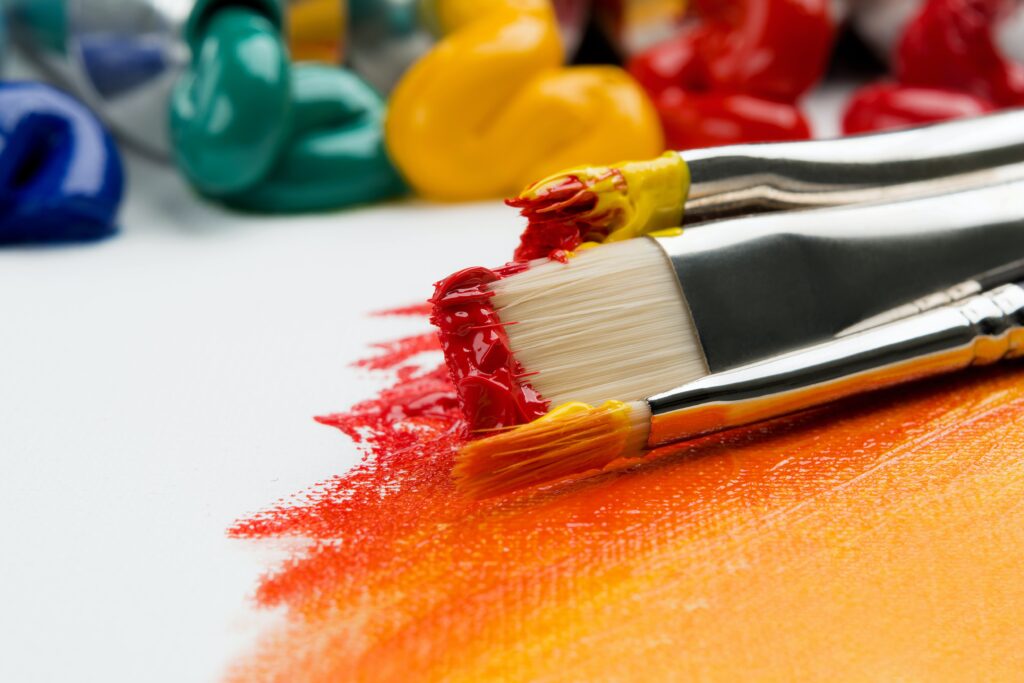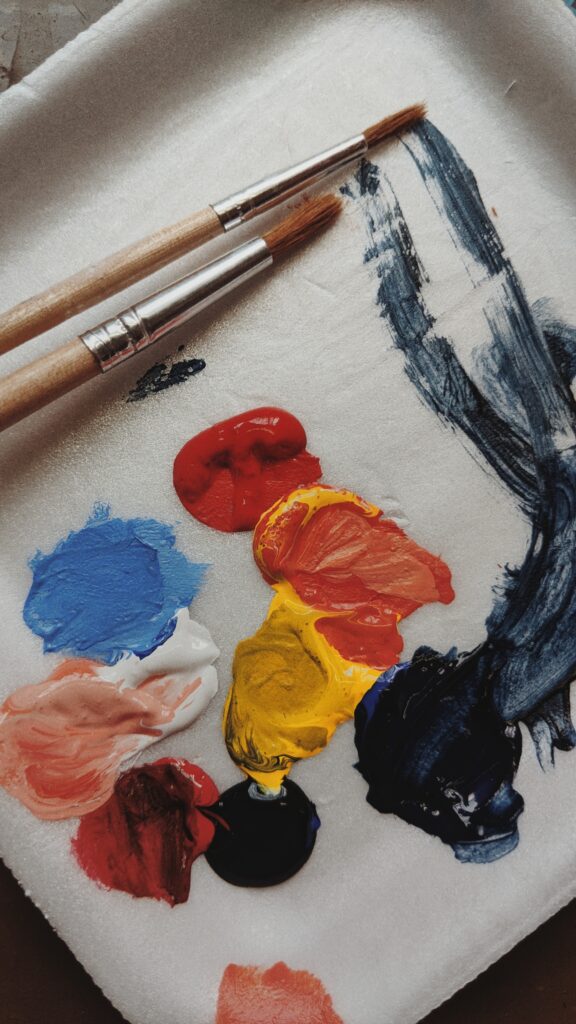Have you ever wondered if it’s possible to sand acrylic paint? Well, the answer is yes! Believe it or not, you can actually sand acrylic paint to achieve the desired finish. Whether you’re working on a painting or a craft project, sanding can come in handy to smooth out imperfections or create a unique texture.
Sanding acrylic paint is a fairly simple process, but it does require some patience and proper techniques. First, ensure that your paint is fully dried and cured before you start sanding. Use a fine-grit sandpaper, like 400 or 600 grit, to gently sand the painted surface in circular motions. Keep in mind that sanding will help you achieve a matte, satin, or even a glossy finish, depending on your preference. Just remember to take your time and gradually work your way through the layers until you reach the desired result. So, don’t be afraid to grab some sandpaper and experiment with sanding acrylic paint to add that professional touch to your next project! Acrylic paint is a versatile and popular medium used by artists, crafters, and DIY enthusiasts worldwide. Whether you’re creating a masterpiece on canvas or adding a splash of color to a home project, understanding how to sand acrylic paint can be incredibly beneficial. In this comprehensive article, we will explore the different aspects of sanding acrylic paint, including its definition, common uses, characteristics, and the need for sanding. We’ll also discuss factors to consider before sanding, suitable types of sandpaper, the step-by-step sanding process, common mistakes to avoid, and what to do after sanding acrylic paint. Additionally, we’ll provide home DIY tips for sanding acrylic paint, introduce professional sanding services, and emphasize the importance of health and safety measures to follow during the sanding process.

Understanding Acrylic Paint
Defining acrylic paint
Acrylic paint is a fast-drying water-based paint that consists of pigment particles suspended in an acrylic polymer emulsion. It is known for its versatility, vibrant colors, and ease of use. Acrylic paint can be used on various surfaces, including canvas, wood, metal, plastic, and more, making it a popular choice for both artists and DIY enthusiasts. With its ability to adhere to a wide range of materials and its durability, acrylic paint provides endless possibilities for creativity.
Common uses of acrylic paint
Acrylic paint is commonly used in artistic and creative endeavors. It is a favorite among painters, whether they are working on canvases, creating murals, or experimenting with mixed media techniques. Acrylic paint is also widely used in crafts, such as decorative painting, DIY home projects, and even model making. Its versatility allows artists and hobbyists to explore various techniques like glazing, layering, and impasto.
Characteristics of acrylic paint
Acrylic paint has several notable characteristics that contribute to its popularity. First and foremost, it dries quickly, allowing artists to work more efficiently. Unlike oil paints, which can take days or even weeks to fully dry, acrylic paint can dry within minutes or hours, depending on conditions. Additionally, acrylic paint is known for its permanence and lightfastness, meaning that the colors will not fade or degrade over time. It is also resistant to water and chemicals, offering a durable and long-lasting finish. Acrylic paint is available in a wide range of colors, from vibrant and intense hues to more subtle and earthy tones, providing artists with endless possibilities for expression.
The Need to Sand Acrylic Paint
Creating a smooth surface
One of the primary reasons why you might need to sand acrylic paint is to create a smooth surface. Despite the versatility of acrylic paint, it is possible to end up with a textured or uneven finish. Sanding can help you achieve a smooth and flawless surface by removing any imperfections or inconsistencies. Smoothing the surface not only enhances the visual appeal of the finished work but also creates a surface that is easier to work on in subsequent stages, such as adding additional layers of paint or applying varnish.
Preparing for a new coat or paint layer
Another reason you might need to sand acrylic paint is to prepare the surface for a new coat or layer of paint. If you’re working on a project that requires multiple layers of paint, it’s essential to sand the previous layer before applying the next one. Sanding helps to create a rough surface that allows the new layer of paint to adhere more effectively, ensuring better adhesion and preventing peeling or flaking.
Fixing mistakes or flaw spots
Lastly, sanding acrylic paint can also be necessary to fix mistakes or flaw spots. Sometimes, despite the best efforts, accidents happen, and unwanted brush strokes, drips, or other imperfections can mar the finished piece. Sanding these areas can help you blend and smooth out the mistakes, creating a seamless and cohesive look. It’s essential to be cautious and gentle while sanding to avoid damaging or removing too much paint.
Factors to Consider Before Sanding Acrylic Paint
Assessing the hardness of the paint
Before you start sanding acrylic paint, it’s crucial to assess the hardness of the paint. Acrylic paint becomes progressively harder as it dries, so the hardness will vary depending on the stage of drying. If the paint is still wet, it is recommended to wait until it dries completely to avoid smudging or smearing. However, if the paint is dry or cured, it should be safe to proceed with sanding.
Determining the thickness of the paint
The thickness of the acrylic paint layer can also impact the sanding process. If the paint layer is thick, it might require more sanding to achieve a smooth surface. On the other hand, if the layer is thin, excessive sanding may remove too much paint. It’s essential to find the right balance and be mindful of the thickness when sanding.
Checking the age of the paint
The age of the paint can also play a role in the sanding process. Acrylic paint that has been exposed to the elements for an extended period may have hardened or become brittle. In such cases, sanding might be more challenging, and there is a higher risk of damaging the underlying layers or the substrate. It’s advisable to evaluate the age of the paint and take extra precautions if needed.
Types of Sandpaper Suitable for Acrylic Paint
Understanding grit numbers
When it comes to sanding acrylic paint, choosing the right type of sandpaper is crucial. Sandpaper is available in various grit numbers, which indicate the coarseness or fineness of the abrasive particles on the paper. Lower grit numbers, such as 80 or 120, are more coarse and suitable for heavy-duty sanding, while higher grit numbers, such as 220 or 400, are finer and used for smoothing and refining surfaces.
Choosing between wet and dry sandpaper
In addition to grit numbers, you can choose between wet and dry sandpaper. Dry sandpaper is commonly used for sanding acrylic paint, especially when working on smaller projects or details. Wet sandpaper, on the other hand, is used in combination with water as a lubricant and is particularly useful for larger surfaces or when a smoother finish is desired. Wet sanding minimizes dust particles and helps prevent the sandpaper from clogging.
Recommended sandpaper types for acrylic paint
For sanding acrylic paint, it is generally recommended to start with a medium-grit sandpaper, such as 120 or 180, to remove any roughness or imperfections. As you progress, you can switch to a finer grit sandpaper, such as 220 or 320, to achieve a smoother surface. It’s important to use gentle and even strokes while sanding, applying light pressure to avoid damaging the paint or surface.

Step-by-Step Sanding Process
Gathering necessary materials
Before you begin sanding acrylic paint, gather all the necessary materials. This includes appropriate sandpaper, a sanding block or foam pad, a clean cloth or sponge, and a bucket of water if you’re using wet sandpaper. It’s also essential to use gloves and protective eyewear to ensure your safety.
Preparing the paint surface
Start by preparing the paint surface. Remove any loose particles or debris using a clean cloth or sponge. If there are any obvious flaws or rough areas, you can use a light sanding block or foam pad to gently smooth them out before proceeding with sanding.
Proper sanding techniques
Once the paint surface is prepared, begin sanding using the appropriate sandpaper. If you’re using dry sandpaper, hold it firmly in your hand or wrap it around a sanding block. Use light circular or back-and-forth motions, working systematically across the entire surface. It’s important to maintain a consistent pressure and avoid applying too much force, as this could damage the paint or underlying layers. If you’re using wet sandpaper, dip it in water and squeeze out any excess before sanding.
Cleaning after sanding
After sanding, clean the sanded surface to remove any residue or dust. Use a clean cloth or sponge dampened with water to wipe away the particles. It’s essential to ensure the surface is entirely dry before proceeding to the next step.
Common Mistakes to Avoid While Sanding Acrylic Paint
Sanding without proper protective gear
When sanding acrylic paint, it is crucial to protect yourself by wearing appropriate protective gear. This includes gloves to protect your hands from abrasion, as well as protective eyewear to shield your eyes from particles. Breathing in dust particles can also be harmful, so consider wearing a dust mask or working in a well-ventilated area.
Using the wrong grade of sandpaper
Using the wrong grade of sandpaper can lead to unwanted results. If the sandpaper is too coarse, it can remove too much paint or create noticeable scratches on the surface. If it’s too fine, it might not be effective in smoothing out imperfections. It’s important to choose the appropriate grit number based on the requirements of your project and to adjust as needed throughout the sanding process.
Over-sanding
Over-sanding can cause irreversible damage to the acrylic paint or the underlying layers. It’s important to proceed with caution and to avoid sanding too aggressively. Regularly check your progress, and stop sanding once you have achieved the desired smoothness. Remember, it’s easier to remove more paint in the future than to repair or repaint damaged areas.

What to Do After Sanding Acrylic Paint
Cleaning the sanded surface
After sanding acrylic paint, it’s essential to clean the sanded surface thoroughly before proceeding with any additional steps. Use a clean cloth or sponge dampened with water to wipe away any dust or residue. Ensure the surface is entirely dry before moving on to the next stage.
Applying a new layer of paint
Once the sanded surface is clean and dry, you can proceed to apply a new layer of paint if desired. Whether you’re fixing mistakes, enhancing colors, or adding more depth and texture, acrylic paint provides the opportunity for endless creativity. Follow the instructions provided by the manufacturer of the paint you are using.
Applying a varnish for protection
To protect your newly painted surface and enhance its durability, consider applying a varnish. Varnish provides an additional layer of protection, preventing damage from UV light, moisture, and general wear and tear. There are various types of varnishes available for acrylic paint, including matte, satin, and glossy finishes. Choose the one that best suits your desired aesthetic and follow the manufacturer’s instructions for application.
Home DIY Tips for Sanding Acrylic Paint
Creating a safe and effective sanding area
When sanding acrylic paint as part of a home DIY project, it’s essential to create a safe and effective sanding area. Choose a well-ventilated space to avoid inhaling dust particles, or consider using a dust extraction system or wearing a dust mask. Keep your workspace clean and organized, ensuring there is ample room to move around and work comfortably. Cover surrounding surfaces or objects with protective sheets or plastic to prevent them from getting damaged or dusty.
Tips for sanding small details or difficult spots
Sanding small details or difficult spots can be challenging, but with the right techniques, it becomes more manageable. For intricate areas, consider using a smaller piece of sandpaper or wrapping sandpaper around a thin dowel or toothpick to reach the desired spot. Take your time and be patient to achieve the desired results without compromising the overall integrity of the piece.
Cost-effective sanding supplies
Sanding supplies can quickly add up, but there are cost-effective options available. Look for multipacks or bulk options when purchasing sandpaper to save money. Additionally, reusable sanding blocks or foam pads are more cost-effective in the long run compared to disposable sanding sponges. By being resourceful and investing wisely, you can continue to enjoy the creative process without breaking the bank.
Professional Sanding Services for Acrylic Paint
Understanding professional sanding services
While sanding acrylic paint can be done as a DIY project, there are instances where professional sanding services may be beneficial. Professional sanding services are typically offered by specialized businesses or professionals with experience in surface preparation and restoration. These services can save you time and ensure a high-quality finish, especially for larger projects or when dealing with valuable artworks.
Types of businesses that offer sanding
Various types of businesses offer professional sanding services for acrylic paint. These include painting contractors, furniture refinishers, auto body shops, and industrial painting services. Depending on your specific needs, you can research and find a reputable business that specializes in the type of surface or project you’re working on.
How to hire a professional sander
When hiring a professional sander, it’s essential to do thorough research to ensure you choose the right one for your project. Seek recommendations from friends, read online reviews, and ask for samples or examples of their previous work. Request quotes from multiple professionals and compare their pricing, offerings, and turnaround time. Additionally, communicate your specific requirements to ensure they have the expertise and equipment necessary to handle your project.
Health and Safety Measures while Sanding Acrylic Paint
Proper ventilation
Proper ventilation is crucial when sanding acrylic paint. Whether you’re working indoors or outdoors, it’s important to ensure there is adequate airflow to prevent the build-up of dust particles and fumes. Open windows and doors, use fans, or consider using a dust extraction system to minimize exposure to potentially harmful substances.
Choosing suitable protective gear
Protective gear plays a vital role in ensuring your safety while sanding acrylic paint. Wear gloves to protect your hands from abrasion and potential exposure to chemicals. Protective eyewear will shield your eyes from dust particles and flying debris. Additionally, consider wearing a dust mask or respirator to prevent inhaling fine particles. Always follow the manufacturer’s instructions for proper use and care of protective gear.
Keep your workspace clean and free from dust
Maintaining a clean workspace is essential for the health and safety of yourself and others. Regularly clean and sweep the area to remove dust particles and debris. Consider using a damp cloth or sponge to wipe surfaces and prevent dust from becoming airborne. Dispose of used sandpaper and other materials properly to avoid potential hazards.
Now that you have a comprehensive understanding of sanding acrylic paint, you can confidently tackle your next creative project or home improvement endeavor. Remember to assess the hardness and thickness of the paint, choose suitable sandpaper, follow the step-by-step sanding process, and take appropriate health and safety measures. Whether you choose to sand the acrylic paint yourself or opt for professional services, ensure that you enjoy the process and embrace the transformative power of sanding acrylic paint. Happy sanding!



